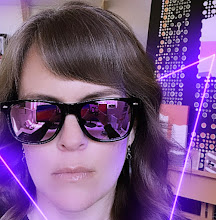I started this post last week, before the whole Etsy debacle, which seems weirdly prescient now. In short, my Etsy shop is one of a handful of things I've let go over the past few years, something I've been mulling over during this most recent professional transition (not to mention all the decade stuff going around - the "best of" lists, decade edition, the me in 2009 vs me in 2019, which was coincidentally the lifespan of my Etsy shop). A lot has happened even just since my last blog post, at the beginning of this academic year (I quit Facebook, for starters, plus lunch the week I tried intermittent fasting...you get the idea), when I was still spending a lot of time mulling over my podcast and next steps, should there be any. Thing is, turns out, unlike most people, I'm pretty good at goodbyes! It's a handy skill that I'm not always proud of. But I seem to be doing a lot of it lately.
Let's back up a few years and summarize briefly. It's June, 2017. I, like many rational Americans, have had a rough few months. In addition to the political environment, my husband had spent much of that school year looking for work after the start-up he worked for, well, didn't work out. Friends with more stable jobs reacted with horror, but for those of us used to less job security, it happens. Both of the cats we'd adopted in the last century had died, within six months of each other. I was unhappy at my job and had virtually no time for creative projects, still recovering from the transition from one kid to two. I was at what I'll say now was the beginning of a midlife crisis of sorts. Like menopause, it's ongoing, which, like menopause, no one tells you about.
A long time ago, when I lived with three (significantly less tidy) roommates, I used to play this game where I'd stop taking out the garbage. You know, see how long it would take, how full the garbage would get, before someone else took it out for a change. It would overflow and eventually, I'd give in and take it out. I started to feel this way with some of my relationships, which, and granted, maybe I was being overly self-involved in that "woe is me" way, were beginning to feel very one-sided. I felt like I was always the one initiating social stuff, and outings were always more convenient for the other person. At some point I decided to apply my taking-out-the-garbage test to some of my relationships, seeing how long it would be before the other person contacted me to initiate something instead of it always being the other way around. This time, I refused to give in and take out the garbage, so to speak. Those relationships fizzled.
And then I quit my job with nothing else lined up. I announced it here, including an ambitious list of projects I hoped to tackle over the coming year (one year eventually turned into two). A few months later, after I'd actually left that job (I'd given three months' notice), I wrote more about my decision here. Toward the end of the first academic year of unemployment-by-choice, as I called it, I took stock of the previous nine or so months here. Considering I only had, at most, 20 hours per week to devote to creative projects, it was a fairly productive year.
That summer I spent all but one day out of ten solid weeks with my kids. It was the first time, over nearly ten years of parenting, outside of baby/toddler years, that I'd done that. It was not easy. I half-heartedly looked for paid work again, this one planned year of unemployment coming to an end. But with my youngest kid entering (free) Kindergarten in the fall, meaning I'd have more time and more money, it was too tempting to quit my non-working status just yet. We decided we could swing this single-income arrangement for another year. In addition to making art and writing a screenplay, I decided to pull the trigger on my "artists in offices" podcast idea, having taken a one-day workshop about podcasting (so obviously I was an expert) earlier that year. That turned out to be the primary product of my second year of unemployment-by-choice, feeling very much like a full-time (unpaid) job between about March and May earlier this year. I wrote about the podcast here (nuts and bolts kind of stuff), here (more about the content of the podcast, its title taken from a book of the same name), and here (relevant-to-the-podcast portions of Lewis Hyde's 'The Gift,' a book every creative person should read). A full wrap-up of 2018-19, not that I accomplished much else, can be found here.
One of my goals for 2019-20 was to ease back into paid work. I worked harder in my two years of not working than I did at my previous day job. But, you know, for free. I have zero regrets about leaving that gig, but I feel like working super hard for no money for two years makes one appreciate actually getting paid, even if it's for work that might not be exactly what you dreamed of doing as a kid. When I recommended Felicia Day's memoir during my first year of not working, I wrote about how, after moving to Los Angeles, Day "counterweights the frustration of acting classes and auditions with what eventually turns into a World of Warcraft obsession." I go on to write: "This is, I suspect, how many artists feel about their day jobs (and vice versa). I am not one of them." Well, it's weird, guys, but this is kinda how I feel about my current day job! It's not rocket science, but I feel like I'm doing a good job, and getting positive feedback makes me feel a little bit less defeated, creatively speaking. It's a creative industry, to be sure, but one that's pretty foreign to me (as I write in my Felicia Day memoir review, I've never been much of a gamer). And yet, the vibe at my day job makes me think of artist Theaster Gates: "to make the thing that makes the things." These are also my people.
The job itself came about rather quickly and unexpectedly when a part-time, remote opportunity came up where my husband works. One thing that was frustrating me about looking for work was that all I could find were relatively low-paying (hello non-profit art gigs), full-time positions that included commutes to/from San Francisco (or even farther). Logistically speaking, that wasn't going to work unless we hired a nanny, and on a non-profit arts salary, that was unlikely (and, I mean no judgment by this, but not an arrangement I desired). Then this opportunity came up and, after nearly three months at it, I can confidently say I'm a much better worker when given flexibility and autonomy, regardless of the work I'm tasked to do. I love working from home. My commute is getting my kids to and from school (about 80-90 minutes of my day). I have no complaints.
So what did I bid farewell to so I could do this. Well, to be honest, temporarily anyway (hopefully), my studio practice, writing my screenplay, working on my podcast. I still play the part of default parent and have a lot of time with my kids, by design. The position is part-time so theoretically I should be able to squeeze in some creative projects. But most of my non-working time (4-5 hours a day) is spent with kids; there are some after-school activities but I haven't yet opted for full-time after-care. I did manage to squeeze in a bonus episode early on, but we'll see, now that I know the job and after this holiday season, what 2020 brings in terms of this art/work/family balance.





















